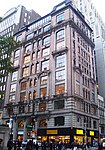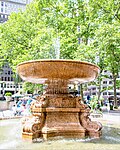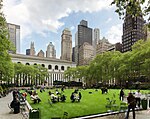Statue of Benito Juárez (New York City)
2002 establishments in New York City2002 sculpturesBronze sculptures in ManhattanBryant ParkMonuments and memorials in Manhattan ... and 6 more
New York (state) sculpture stubsNew York City stubsOutdoor sculptures in ManhattanSculptures of men in New York CityStatues in New York CityStatues of Benito Juárez

Benito Juárez is an outdoor bronze sculpture of Benito Juárez by Moises Cabrera Orozco, located in Bryant Park in Manhattan, New York. Donated by the State of Oaxaca on behalf of the Mexican Government and the Mexican Trade Center, the portrait sculpture was cast in Mexico in 2002 and installed on October 9, 2004. It is the most recent statue in the park, and the first to depict a Mexican.
Excerpt from the Wikipedia article Statue of Benito Juárez (New York City) (License: CC BY-SA 3.0, Authors, Images).Statue of Benito Juárez (New York City)
West 40th Street, New York Manhattan
Geographical coordinates (GPS) Address Website Nearby Places Show on map
Geographical coordinates (GPS)
| Latitude | Longitude |
|---|---|
| N 40.753808 ° | E -73.984638 ° |
Address
Bryant Park
West 40th Street
10018 New York, Manhattan
New York, United States
Open on Google Maps








